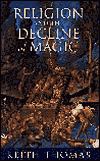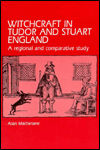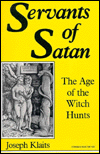The English stereotype



 This
model derived in part from the works of the Elizabethan authors, Reginald
Scot and George Gifford, who from their different viewpoints were highly
critical of villagers' desire to blame their poverty-stricken neighbours
for illness and misfortune. Alan Macfarlane, in the title of an essay
in the collection edited by Sydney Anglo, The Damned Art (1977)
went so far as to describe Gifford, a Puritan minister in Essex, as "a
Tudor anthropologist". The model was promulgated in the work of Keith
Thomas, the massive Religion and the Decline of Magic (1971), and
the regional study of Essex material by his pupil Macfarlane, Witchcraft
in Tudor and Stuart England (1970), based on a 1967 Oxford doctoral
dissertation. Both works leaned heavily on models taken from British
social anthropology, notably in the works of Radcliffe-Brown and Evans-Pritchard.
Neither of these authors made further major contributions, and the history
of witchcraft in England was generally regarded as sufficiently known.
Their work was criticized by anthropologists, who were already moving away
from the functionalist model that Thomas and Macfarlane had borrowed.
In general, however, their work was taken as authoritative and definitive.
This
model derived in part from the works of the Elizabethan authors, Reginald
Scot and George Gifford, who from their different viewpoints were highly
critical of villagers' desire to blame their poverty-stricken neighbours
for illness and misfortune. Alan Macfarlane, in the title of an essay
in the collection edited by Sydney Anglo, The Damned Art (1977)
went so far as to describe Gifford, a Puritan minister in Essex, as "a
Tudor anthropologist". The model was promulgated in the work of Keith
Thomas, the massive Religion and the Decline of Magic (1971), and
the regional study of Essex material by his pupil Macfarlane, Witchcraft
in Tudor and Stuart England (1970), based on a 1967 Oxford doctoral
dissertation. Both works leaned heavily on models taken from British
social anthropology, notably in the works of Radcliffe-Brown and Evans-Pritchard.
Neither of these authors made further major contributions, and the history
of witchcraft in England was generally regarded as sufficiently known.
Their work was criticized by anthropologists, who were already moving away
from the functionalist model that Thomas and Macfarlane had borrowed.
In general, however, their work was taken as authoritative and definitive.
 It
should be noted, however, that they were not saying that beggars were accused.
Joseph Klaits, in his Servants of Satan (1985), described midwives
and beggars as "classic witches". This is not true of either group,
midwives because they were too respectable and beggars because they were
too mobile. Only in the series of Salzburg cases, known as the Zauberjackl
trials, do we see professional beggars being charged with witchcraft.
Such people tended to be vagrants, moved on by parish officers wherever
they went, and therefore not commonly long enough in an area to acquire
a reputation for successful cursing. The "English stereotype" refers
to impoverished members of the community, not outsiders. They were
relying on their membership of local networks to help them cope with temporary
or long-term difficulties.
It
should be noted, however, that they were not saying that beggars were accused.
Joseph Klaits, in his Servants of Satan (1985), described midwives
and beggars as "classic witches". This is not true of either group,
midwives because they were too respectable and beggars because they were
too mobile. Only in the series of Salzburg cases, known as the Zauberjackl
trials, do we see professional beggars being charged with witchcraft.
Such people tended to be vagrants, moved on by parish officers wherever
they went, and therefore not commonly long enough in an area to acquire
a reputation for successful cursing. The "English stereotype" refers
to impoverished members of the community, not outsiders. They were
relying on their membership of local networks to help them cope with temporary
or long-term difficulties.
Two empirical problems went largely unnoticed. Thomas's work, which dealt with far more than witchcraft cases, was based on his encyclopedic knowledge of the printed sources. Macfarlane's work was based on a single county, Essex. The witchcraft pamphlets and the demonological authors, whether believing or sceptical, cannot be taken as providing a representative view of English witchcraft cases. The authors had agendas to serve, which shaped their choice of examples. Sceptical authors, such as Scot and Gifford, or Johann Weyer for that matter, had good reason to represent all the accused as poverty-stricken old women, in order to emphasize the ridiculousness of the belief that they were powerful agents of Satan, which was necessary to transform popular accusations of maleficium into trials. Pamphlet writers had an interest in giving the public what they wanted and expected, so male accused and prosperous women tended to be invisible in the trial accounts that were published. They also had no interest in talking about the many accused who were found not guilty. For these and similar reasons, Thomas's view of the case material was a partial one. Macfarlane suffered from a different problem, taking Essex as a synecdoche for England as a whole. Essex saw far more cases than most counties, including several that were published as pamphlets. It also witnessed the outset of the Hopkins panic in the 1640s, and was the home of several sceptical authors, from Gifford to Ady. What was distinctive about Essex, apart from its relatively well-preserved and well-organized records, was that it was a county dominated by Puritans. Its religious character made it highly unusual in England, and especially susceptible to moral panics. The quality of its local records has made it a magnet for historians - James Sharpe wrote his doctoral dissertation on crime in Essex, under Thomas's supervision - but it cannot be taken as typical. Indeed, nowhere can be. England was very various, divided by geography and culture into many distinct regions.
Nevertheless, the Thomas-Macfarlane model was taken as the standard, and the task for historians of other countries, where patterns were different, such as Scotland and Germany, was to explain the differences from England. Legal systems and religion and culture and economics were included in the mix by various authors, but the "English stereotype" was regarded as firmly established.
Where are we now? The empirical work of James Sharpe and Malcolm Gaskill, among others, has uncovered rather more variation in England than had been thought to be the case. The refusal of requests for charity now looks to be one pattern of hostility causing accusations in England, but not the only one. Other parts of England than Essex reveal different patterns of prosecution, in terms of frequency, conviction rates, and gender balance. On the other hand, the sharpness of the contrast with European material has declined, as more regional studies have been undertaken. The big witch trials seen in some parts of Europe, but rarely in England, now seem something of an aberration. Most accusations in France or Germany involved groups of villagers complaining about a neighbour, and even during panics the depositions had to come from people who knew the accused personally rather than from the investigators. The "English stereotype" now looks less prominent in England than formerly and more common elsewhere than used to be thought. Refusing to be charitable now looks like one among several sources of hostility.
Robin Briggs notes that continental demonologists emphasized
the frequency of such occurrences, as when Rémy suggested that most
witches were beggars who hoped to make money by curing the illnesses they
had caused. He also drew attention to the curses which came "to the
lips of witches in our time when they have been begging and someone has
refused them; for nothing is so common as for them to utter a wish that
all his family may die of starvation, that his wife may give birth to monsters,
and his whole house be infected with prodigies and portents". All the authorities
agreed that witches were poor and miserable, often driven to make a pact
with Satan out of despair. Bodin thought that the charitable enjoyed special
protection, and in a remarkable passage claimed that:
"the witches
confess that the charitable person cannot be harmed by their spells, even
if he is otherwise wicked . . . This is why the witches who are compelled
by Satan to do evil, to kill and poison men and animals on pain of perpetual
torment, when they have no enemies on whom they can take vengeance, go
begging, and anyone who has anything to give and refuses them will be in
danger, as long as he does not know they are witches. For the witch has
no greater power than that over the person who gives alms knowing that
he gives to a witch. And one must be very careful not even to give to those
who are reputed so; but any who refuse them alms, not knowing them to be
witches, will have great difficulty escaping unscathed, as has often been
proved. And in truth when I was at Poitiers for the Grands Jours
of 1567, as one of the substituts of the procureur général,
I heard of two pitiful and poor witches, who asked for charity at a rich
house. When they were refused they bewitched the house, and all the inhabitants
contracted rabies and died mad. It was not the cause for God to deliver
them into the power of Satan and his agents the witches, but since they
were wicked in other ways, and had no pity for the poor, God had no mercy
for them."
Briggs, in Communities of Belief, comments on this passage, "Despite this striking piece of evidence, the strict refusal/guilt syndrome found in England cannot be exported unchanged to French-speaking Europe. Too many of the specific accusations do not quite fit within it. What becomes clear is that the English cases form a sub-set within a more general aggression-guilt model, which does encompass the majority of the French evidence. Most of the quarrels between witch and victim involved overt hostility, with the denial of neighbourliness extending over a much wider field than the straightforward refusal of alms, so that guilt would not necessarily have been induced by the consciousness of failure to perform a socially expected act of charity."
Thus the "English stereotype" can be seen as one form of a more general pattern, that of hostility and suspicion between neighbours, sometimes extended over decades or even several generations. This therefore throws the historian back on the examination of communities, to see what kinds of conflicts might reach the level of formal accusations. Some historians are looking at large-scale phenomena such as famine, while others are investigating small communities in detail. Of especial interest will be the investigation of communities where witchcraft accusations were not made. Since the inhabitants of one village in Essex or one small state in Germany presumably held similar beliefs to those who lived in nearby communities, one needs to ask what restrained them from accusing their neighbours. Looking at the micro-politics of the situation might be more productive than recycling or modifying the functionalist explanations of Thomas and Macfarlane, which make accusation look so useful as a social mechanism that everyone should be doing it. More recently historians have focused on the dynamics, rather than functionality, of witchcraft belief, particularly at the village level, on the ways these beliefs negotiated differences in class, age, and gender, and on the ways they framed issues of authority and social order both before and after legal proceedings were initiated. [See various essays by Malcolm Gaskell, and also Annabel Gregory, "Witchcraft, Politics, and 'Good Neighbourhood' ", Past and Present 133 (1991).]